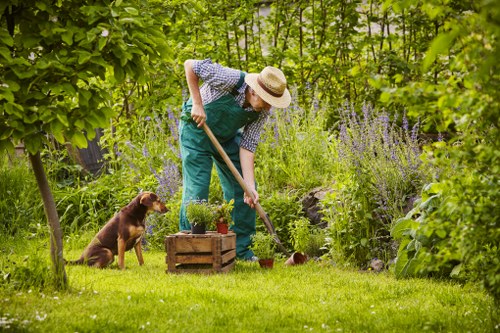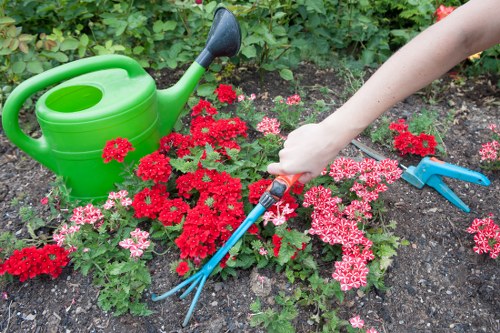Lawn Mowing West London: Your Ultimate Guide to a Beautiful Lawn

Maintaining a lush, green lawn in West London can be a rewarding yet challenging task. With varying weather conditions and different grass types, achieving that perfect mow requires knowledge, dedication, and the right tools. Whether you're a homeowner or managing a large property, understanding the nuances of lawn care in West London is essential.
In this comprehensive guide, we'll explore essential tips and tricks for effective lawn mowing, the best times to mow, tools you'll need, and how to tackle common lawn issues. Our goal is to help you create and maintain a beautiful lawn that enhances the appeal of your West London property.
Let's dive into the world of lawn mowing in West London and discover how you can transform your outdoor space into a stunning green oasis.
Why Lawn Mowing is Important in West London

Lawn mowing is more than just a routine chore; it's a crucial aspect of maintaining the health and beauty of your garden. In West London, where properties vary from traditional Victorian homes to modern apartments with communal gardens, a well-mowed lawn can significantly enhance curb appeal and overall property value.
Regular mowing helps to:
- Promote Healthy Growth: Cutting the grass at the right height encourages stronger root systems and healthier grass.
- Prevent Weeds: A well-maintained lawn can outcompete weeds, reducing the need for chemical treatments.
- Enhance Aesthetics: A neat, green lawn immediately boosts the visual appeal of your property.
In West London, where space can be limited, especially in urban areas, a well-kept lawn serves as a peaceful retreat and a green space for relaxation.
Understanding the Climate of West London

West London experiences a temperate maritime climate, characterized by mild winters and warm summers. This climate is generally favorable for grass growth, but it also means dealing with occasional rain and fluctuating temperatures.
Key climate considerations for lawn mowing include:
- Seasonal Growth Patterns: Grass grows at different rates depending on the season, requiring adjustments in mowing frequency.
- Rainfall: Heavy rains can lead to muddy lawns, making mowing difficult and potentially damaging the grass.
- Temperature Fluctuations: Extreme temperatures can stress grass, making proper mowing techniques essential.
By understanding these climate factors, you can tailor your lawn care routine to suit the specific conditions of West London.
Best Practices for Lawn Mowing

Achieving a well-mowed lawn requires more than just cutting the grass. Implementing best practices ensures that your lawn remains healthy, vibrant, and free from common issues.
Here are some essential lawn mowing practices for West London:
1. Mowing Frequency
The ideal mowing frequency depends on the growth rate of your grass, which is influenced by the season and weather conditions.
- Spring and Summer: During the growing season, mow your lawn once a week to keep the grass at an optimal height.
- Autumn: Reduce mowing frequency as grass growth slows down.
- Winter: Minimal mowing is required, focusing on removing debris and keeping the lawn tidy.
2. Mowing Height
Setting the right mowing height is crucial for grass health. Cutting the grass too short can stress the plants, while leaving it too long can lead to weed growth.
- Cool-Season Grasses: Maintain a height of 2.5 to 3.5 inches.
- Warm-Season Grasses: Keep the grass between 1.5 to 2.5 inches.
Adjust your mower settings accordingly to achieve the desired height.
3. Mowing Techniques
Proper mowing techniques can make a significant difference in the health and appearance of your lawn.
- Mow When Dry: Wet grass can clump and clog your mower, leading to an uneven cut.
- Change Mowing Patterns: Vary your mowing direction each time to prevent grass from leaning in one direction.
- Leave Clippings: Grass clippings can act as a natural fertilizer, returning nutrients to the soil.
By following these techniques, you can ensure a clean, even mow that promotes healthy grass growth.
Essential Tools for Lawn Mowing

Having the right tools is essential for effective lawn mowing. Whether you prefer manual mowing or using power equipment, investing in quality tools can save you time and effort.
- Mowers:
- Push Mowers: Ideal for small lawns, providing control and precision.
- Reel Mowers: Eco-friendly option that cuts grass blades cleanly.
- Electric or Gas Mowers: Suitable for larger lawns, offering powerful performance.
- String Trimmers: Perfect for edging and trimming areas that the mower can't reach.
- Lawn Aerator: Helps improve soil health by reducing compaction and increasing air flow.
- Rakes and Blades: Essential for cleaning up grass clippings and debris post-mowing.
Regular maintenance of these tools ensures they operate efficiently, providing you with a smooth mowing experience.
Tackling Common Lawn Issues in West London

Even with the best practices, lawns in West London can face various challenges. Understanding these common issues and knowing how to address them is key to maintaining a healthy lawn.
1. Weeds
Weeds compete with grass for nutrients, sunlight, and water. Regular mowing at the correct height can prevent weeds from establishing. Additionally, consider using eco-friendly herbicides or natural weed barriers to keep your lawn pristine.
2. Pests
Pests like grubs and caterpillars can damage your lawn by feeding on grass roots and blades. Monitoring your lawn for signs of infestation and using appropriate pest control measures can protect your grass from severe damage.
3. Fungal Diseases
Moist conditions in West London can lead to fungal diseases such as powdery mildew and rust. To prevent these issues, ensure proper lawn drainage, avoid overwatering, and maintain adequate mowing height to promote air circulation.
4. Drought Stress
Periods of drought can stress your lawn, causing grass to become brown and weak. Implementing a regular watering schedule, preferably in the early morning, and using drought-resistant grass varieties can help mitigate this issue.
Choosing the Right Lawn Mowing Service in West London

If maintaining your lawn becomes overwhelming, hiring a professional lawn mowing service in West London can be a smart decision. Professional landscapers offer expertise, save you time, and ensure your lawn remains in top condition.
What to Look for in a Lawn Mowing Service
- Experience and Reputation: Choose a service with proven experience and positive customer reviews.
- Services Offered: Ensure they provide a comprehensive range of services, including mowing, edging, and lawn care treatments.
- Pricing: Compare pricing structures and choose a service that offers value for money without compromising quality.
- Eco-Friendly Practices: Opt for services that use sustainable practices and eco-friendly products to minimize environmental impact.
By carefully selecting a reputable lawn mowing service, you can enjoy a beautiful lawn without the hassle of doing it yourself.
Top Lawn Mowing Services in West London
- GreenScape Professionals: Known for their reliability and comprehensive lawn care solutions.
- West London Lawn Care: Offers personalized services tailored to your lawn's specific needs.
- EcoMow Services: Specializes in eco-friendly mowing practices, perfect for environmentally conscious homeowners.
Seasonal Lawn Mowing Tips

Each season in West London brings unique challenges and opportunities for your lawn. Adapting your mowing and lawn care practices to the seasons ensures consistent health and beauty year-round.
Spring
As the weather warms, grass starts to grow actively. It's essential to:
- Rake Debris: Remove dead grass and leaves to prevent mold growth.
- Start Regular Mowing: Begin mowing once a week to keep up with growth.
- Fertilize: Apply a balanced fertilizer to support healthy growth.
Summer
Hot and dry conditions require careful lawn management:
- Water Wisely: Water early in the morning to reduce evaporation.
- Mow Higher: Increase mowing height to provide shade and retain moisture.
- Control Weeds: Keep mowing regularly to prevent weeds from taking over.
Autumn
Preparing your lawn for the colder months involves:
- Final Mows: Continue regular mowing until growth slows.
- Leaf Removal: Keep the lawn free of fallen leaves to prevent disease.
- Aeration: Aerate the lawn to improve soil health and prepare for winter.
Winter
While grass growth slows, maintenance is still important:
- Minimal Mowing: Only mow as needed to remove debris.
- Protect the Lawn: Avoid heavy foot traffic to prevent damage.
- Plan for Spring: Assess the lawn and plan any necessary treatments for the upcoming season.
Eco-Friendly Lawn Mowing in West London

As environmental concerns grow, eco-friendly lawn mowing practices have become increasingly important. Implementing sustainable methods not only benefits the environment but also promotes a healthier lawn.
Benefits of Eco-Friendly Mowing
- Reduces Carbon Footprint: Using electric or manual mowers decreases emissions compared to gas-powered alternatives.
- Enhances Soil Health: Leaving grass clippings on the lawn recycles nutrients back into the soil.
- Conserves Water: Sustainable practices like mowing at higher heights help retain moisture in the soil.
Tips for Eco-Friendly Lawn Mowing
- Choose the Right Mower: Opt for electric mowers or manual reel mowers to minimize emissions.
- Mulch Mowing: Use mulching blades to finely chop grass clippings, allowing them to decompose quickly.
- Limit Chemical Use: Reduce reliance on chemical fertilizers and pesticides by adopting natural lawn care methods.
- Implement Rainwater Harvesting: Use collected rainwater for lawn irrigation to conserve water resources.
By adopting these eco-friendly practices, you contribute to a greener West London and enjoy a healthier, more resilient lawn.
Local Relevance: Lawn Mowing in Surrounding Areas

West London is surrounded by vibrant neighborhoods, each with its unique charm and lawn care needs. Understanding the specific requirements of these areas can help you tailor your lawn mowing practices effectively.
1. Chiswick
Known for its picturesque streets and green spaces, Chiswick residents prioritize maintaining their lawns to complement the area's beauty.
2. Ealing
Ealing boasts a mix of urban and suburban lawns. Homeowners here often seek professional services to manage larger garden areas.
3. Hammersmith
With its bustling community, Hammersmith lawns require regular maintenance to stay neat amidst the urban environment.
4. Richmond
Richmond's expansive parks and private gardens demand high standards of lawn care to preserve their natural beauty.
5. Shepherd's Bush
Urban lawns in Shepherd's Bush benefit from efficient mowing schedules and space-saving techniques.
6. Acton
Acton's diverse properties mean lawn care solutions need to be adaptable to different garden sizes and styles.
7. Fulham
Fulham residents often invest in premium lawn care services to maintain their elegant gardens.
8. Putney
Putney's riverside locations require lawns to be resilient against moisture and occasional flooding.
9. Kensington
Kensington's upscale properties demand meticulous lawn care to uphold property values and aesthetic standards.
10. Hounslow
Hounslow's family-friendly neighborhoods often have larger lawns, necessitating regular and thorough maintenance.
11. Brentford
Brentford's blend of residential and commercial areas requires efficient lawn care solutions to cater to various property types.
12. Twickenham
Twickenham's green spaces and gardens are a key feature, with residents keen on maintaining their lawns for both beauty and recreation.
13. Isleworth
Isleworth's community-focused neighborhoods appreciate well-maintained lawns as gathering spots for families and friends.
14. Barnes
Barnes' village-like ambiance makes lawn care a priority for preserving the area's charm and tranquility.
15. Kensington High Street
This bustling area combines commerce with residential gardens, requiring flexible lawn mowing services to accommodate diverse needs.
Conclusion
Maintaining a beautiful lawn in West London is achievable with the right knowledge, tools, and practices. Whether you choose to mow your lawn yourself or hire a professional service, understanding the local climate, seasonal changes, and specific area requirements can make a significant difference.
By following the best practices outlined in this guide, you can enjoy a lush, green lawn that enhances the beauty of your West London property. Remember, a well-maintained lawn not only boosts curb appeal but also provides a serene space for relaxation and enjoyment.
Investing time and effort into lawn care today will reward you with a vibrant, healthy lawn for years to come.
Frequently Asked Questions
1. How often should I mow my lawn in West London?
During the growing season (spring and summer), mowing once a week is ideal. In autumn, reduce the frequency as growth slows, and in winter, mow minimally to remove debris.
2. What is the best time of day to mow the lawn?
The best time to mow is in the late morning or early afternoon when the grass is dry. Avoid mowing in the early morning or late evening when dew is present.
3. Should I leave grass clippings on the lawn?
Yes, leaving grass clippings can act as a natural fertilizer, returning nutrients to the soil. However, ensure that clippings are not too thick to prevent matting.
4. What type of mower is best for a medium-sized lawn?
An electric mower is suitable for medium-sized lawns, offering a balance between power and eco-friendliness. Alternatively, a gas mower can be used for more extensive areas.
5. How can I prevent weeds from taking over my lawn?
Regular mowing at the correct height, proper watering, and fertilizing can help prevent weeds. Additionally, consider using natural weed barriers or eco-friendly herbicides for added protection.